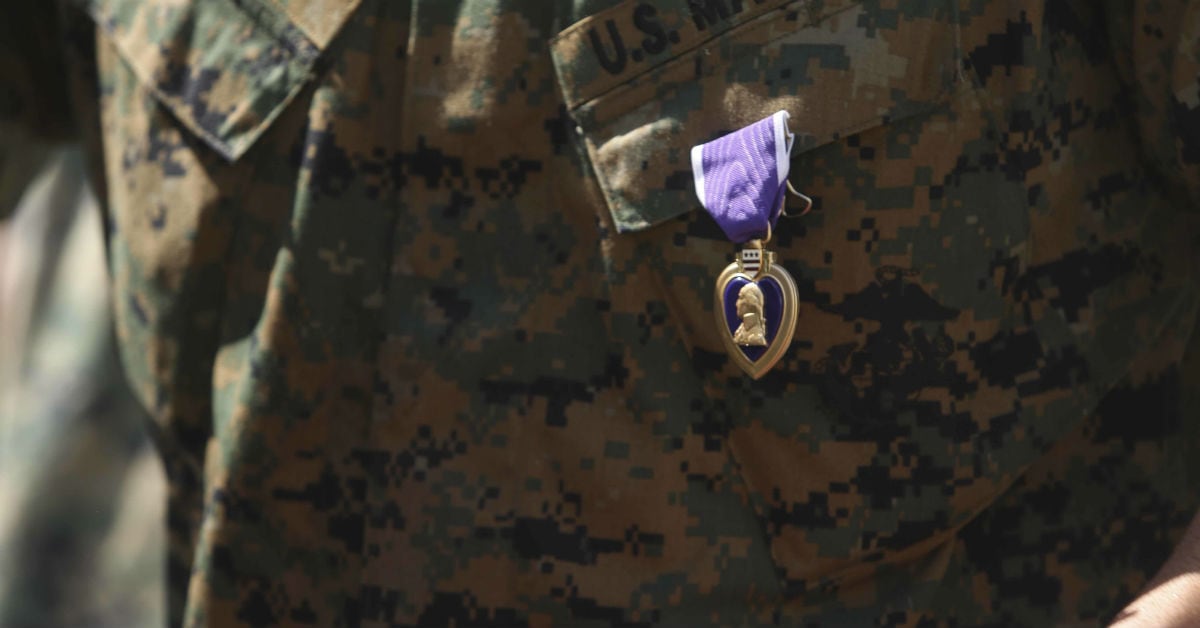For more than 85 years, the Military Order of the Purple Heart has united veterans wounded in combat, a fraternity literally forged with blood.
The charity’s focus and crown jewel is the National Service Program, which helps veterans of all stripes navigate the bureaucracy involved in filing a benefits claim with the Department of Veterans Affairs.
The program bankrolls dozens of caseworkers nationwide and submitted more than 12,000 VA claims in fiscal year 2017, obtaining nearly $214 million in benefits along the way, according to the non-profit.
“They don’t know how to deal with the VA,” said Ron Siebels, an Order member who was wounded in Vietnam. “We go to bat for them.”
But that vital mission, and the pending VA claims of an untold number of veterans, were thrown into disarray in April, when the Order announced the program would end as of June 30.
A press release blamed the Military Order of the Purple Heart Service Foundation, also known as the Purple Heart Foundation, a sister entity that is tasked with raising funds for the Order.
The Foundation funds the Order via annual grants, and the National Service Program offers a service that veterans advocates say is already in short supply.
RELATED

“They failed us,” Neil Van Ess, the Order’s national commander, said at the time.
But a few weeks later, the program’s cancellation was reversed, and the Order issued statements that said the vital program would continue at a reduced funding level.
Whatever the reason for the reversal, the about-face and diminished level of funding offer the latest glimpse into the charity’s troubled financial state.
The Foundation has been hemorrhaging money in recent years, according to its annual tax filings, imperiling the Order’s ability to continue its vital work.
It reported losing nearly $2 million in fiscal year 2016, and $5.2 million in fiscal 2017, according to records.
While the Foundation’s 2017 tax filings show it losing millions, those records also show its public support nearly doubling in recent years, from about $16 million in 2012 to nearly $31 million in 2016.
The reasons for this discrepancy remain unclear.
The Foundation’s highest-paid employee, CEO Steve Ruckman, did not respond to repeated requests for comment and emailed questions from Military Times.
His compensation has increased over the years, from about $150,000 in 2010 to nearly $215,000 as of 2017, according to the tax filings.

The Order and the Foundation have existed for decades, but critics say Foundation leadership is too tied to outdated fundraising plans that lose money, including used car and household goods donations.
Other public-service programs run by the Order have been cut in recent years as well, critics say, and a generational divide has arisen among Order members who spilled their blood in different American wars.
Some Iraq veterans have quit in recent years, alleging that the Foundation wasn’t straight with them about financial issues.
All this has left some Purple Heart patriots wondering why the Foundation holds the power of the purse over the Order in the first place.
The Foundation’s financial problems are not new, according to Stephanie Kalivas, an analyst with the American Institute of Philanthropy’s Charity Watch, which grades non-profits on how efficiently they spend their donations.
“We’ve given them an F for a long time,” she said.
Tax filings show the Foundation has provided less money to the Order in recent years, Kalivas said.
“Fiscal year 2015, it was over $8.7 million,” she said. “I don’t know what happened in fiscal 2016, it went down to less than $4 million. Fiscal 2017, it was back to almost $7 million.”
Kalivas also noted that the Foundation’s available balance dropped by nearly 40 percent from fiscal 2016 to fiscal 2017.
Part of the Foundation’s woes appear to be because it pays too much to professional fundraisers and gets too little in return, she said.
The Foundation reported raising $24.9 million overall in fiscal 2017, but the organization only kept about $8.5 million, with the rest going to pay the fundraisers it hired, according to records.
The foundation raised $13.7 million through a household goods donation program, but had to pay $11.4 million to GreenDrop, an organization that ran the effort for them, according to the 2017 filing.
“The bottom line is they’re spending a whole lot of money on professional fundraisers, and they’ve been doing that a long time,” Kalivas said. “They don’t have any money left for their programs.”
The Foundation at times has invested in fundraising agreements that end up costing more than they bring in, according to records.
In one instance, the Foundation lost about $193,000 in fiscal 2017 because it paid nearly $505,000 to a company for a fundraising campaign that only brought in about $311,000, according to records.
A key metric for grading a charity is how much money goes toward actual program services versus other costs, Kalivas said.
Top-rated charities generally spend 75 percent or more of their budget on programs and less than 25 percent on fundraising and other costs, she said.
The Foundation, she said, spends just 25 percent on actual programs, and it costs $89 to raise $100.
“That’s incredibly high,” Kalivas said.
Despite their laudable efforts, veteran charities often receive poor grades due to inefficient operations, she said.
“Unfortunately, these charities have these terrible marketing agreements with the professional fundraisers, where the for-profit fundraisers are really benefitting,” Kalivas said. “Every time you give $50, [fundraisers] are keeping $35 or $40 of it. There’s not a lot left to do for veterans.”
Charity Watch isn’t the only organization to point out such inefficiencies.
Less than 6 percent of the proceeds from a Purple Heart Foundation telemarketing fundraiser went to charitable operations in 2012, according to the New York State Attorney General.

The Foundation’s financial troubles first surfaced in 2008, when ABC News reported that then-Foundation president Richard Esau was fired over conflict-of-interest allegations.
Henry Cook, then the Order’s national commander, accused the Foundation under Esau of giving $500,000 to the Intrepid Museum in New York, right before the daughter of a Foundation board member was hired by the museum, ABC reported.
Cook also alleged that the Foundation gave $100,000 to the Marine Corps Reserve Officers Association where Esau had worked before joining the Foundation, and where his wife continued to work at the time of the donation, according to ABC.
Esau later insisted he had been wrongfully terminated at an Order meeting, Cook told ABC.
Ron Siebels was a soldier deployed to Vietnam when he was injured in an explosion.
He later joined the Order and served as the Foundation’s treasurer.
But Siebels said he quit last year over concerns with Foundation finances and leadership after getting “tired of the crap that I saw.”
The Foundation has had to withdraw money from its investment accounts to cover bills, and continues fundraising strategies that have already failed, he said.
He doesn’t know why the Foundation shows such resistance to change.
“People there know what’s going on and won’t do anything about it,” he said. “I got to the point where I felt like I was swimming in someone else’s cesspool, and I’m not going to continue this. Everything they’ve done to try and raise funds has backfired.”
Siebels said he was horrified when the Order announced plans to end the program that helps veterans file VA claims.
“It’s total mismanagement,” Siebels said.
The Order’s national convention is later this summer, and Siebels said he hopes it can disentangle itself from the Foundation.
“I hope we throw the Foundation out,” he said. “They’ll probably sue because they think they own the Purple Heart [trademark]. They weren’t there when I was wounded and left for dead.”
Jason Johns was a soldier back in October 2003, when his unarmored Humvee hit an anti-tank landmine in Iraq.
Johns was knocked out, riddled with shrapnel and later received the Purple Heart.
Johns said he was serving as the Order’s national judge advocate in 2016 when he noticed the “funny numbers” in the finances.
He said he and other Order members asked to look at the Foundation’s books.
“The response was vitriol,” Johns said.
He later quit his position and said “it didn’t come as a shock” when he heard of plans to end the National Service Program.
Johns said the Foundation’s problems stem from failing to adapt to the times, a problem that he partially attributes to a generational schism between older and younger Purple Heart recipients.
The World War II members are largely gone and Vietnam vets are running things, said Johns, now a private attorney in Wisconsin who helps veterans with claim appeals.
The older leaders have been resistant to new ideas, Johns said.
He recalled being rebuffed when he and another Iraq vet approached the Foundation about working with a PR firm that was offering to rebrand and market the charity for free.
“The foundation said no [expletive] thank you, we’ll figure it out,” Johns said.
RELATED
After waiting more than 70 years, World War II veteran and POW, now 94, receives Purple Heart
The Order should have no problem collecting donations, he said, and the marketing possibilities are endless.
“For crying out loud, we’re the Military Order of the Purple Heart,” Johns said. “We were wounded in battle. You ask 98 percent of the civilian population, they know what [the Purple Heart] is. They know what it looks like and know what it means.”
The Order was congressionally chartered decades ago.
Johns said the Congressional charter mandates the charity submit an annual report to Congress, but he is not sure whether that mandate has ever been enforced.
Like Siebels, Johns said he hopes the Order can end its involvement with the Foundation and find a more efficient way to raise money.
“If they keep on this path, they’re going to dissolve,” he said of the Foundation. “They’ll fade away and we’ll create our own organization to fund-raise.”
Geoff is the managing editor of Military Times, but he still loves writing stories. He covered Iraq and Afghanistan extensively and was a reporter at the Chicago Tribune. He welcomes any and all kinds of tips at geoffz@militarytimes.com.




